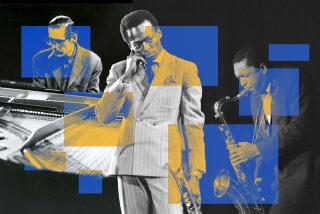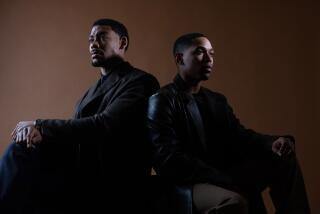MOVIE REVIEW : ‘No Chaser’: A Glance Behind Monk’s Veil
“Thelonious Monk: Straight No Chaser” (at the AMC Century 14) breaks the mold that has long been evident in movies about jazz artists. Unlike the fictional and heavily downbeat “Round Midnight,” or the fictionalized facts of “Bird,” or the depressing Chet Baker documentary “Let’s Get Lost,” this is a superbly crafted mixture of old and new footage. (Monk died in 1982 at 63.) There is virtually no reference to drugs, a common element in all the others, and no apparent objective except that of presenting an honest audio-visual portrait.
Though Monk seemed too esoteric to reach out to a mass audience, the manner in which he and his music are presented here, sandwiched between narrations by his manager, his saxophonist Charlie Rouse and others, could break through the barrier that limited him in his lifetime.
What manner of man was Thelonious Monk? Part of the answer is supplied in footage acquired from a 1968 German TV documentary. Here he is in a recording studio, or a London theater, alone or with a quartet or octet, playing some of the works that have become standards. He seems preoccupied; now and then he leaves the piano and, while the others continue to play, revolves slowly in situ , or performs a dance as quirky as his music.
An off-screen narration by Samuel E. Wright, who played Dizzy Gillespie in “Bird,” outlines Monk’s early years. The musician’s troubles with the police--he lost his right-to-work New York cabaret card for an offense he said he did not commit--are discussed by his manager, Harry Colomby.
As the moment neared for his first chance at mass exposure via a Time magazine cover story, Colomby noticed an increasingly erratic pattern of behavior. Monk’s son, Thelonious Jr., offers a poignant analysis: “(There were) tremendous fits of depression and euphoria, very schizophrenic type thing . . . we had to hospitalize him . . . it’s a startling thing when you look your father in the eye and you know that he doesn’t exactly know who you are.”
There are light interludes: Monk making small talk in a recording studio, trying half coherently to communicate with a waiter in some airport restaurant, yet coming up with a perceptive reaction to a journalist’s foolish question.
Monk’s wife, Nellie, is seen only briefly, though the couple’s closeness is eloquently recalled by Charlie Rouse. The Baroness Pannonica de Koenigswarter, Monk’s patron, discusses her ejection from New York apartments because of her musician friends.
Helped by commendable sound and camera work, such Monk tunes as “Pannonica,” “Round Midnight,” “Ruby My Dear” and “Crepuscule With Nellie” are perfectly accessible with their incisive statements, idiosyncratic runs and engaging dissonances. If “Ugly Beauty” seemed like an apt title for one Monk song, a more orthodox beauty is expressed when “Well You Needn’t” and “Misterioso” are played exquisitely as piano duets by Tommy Flanagan and Barry Harris.
The final tune, “Sweetheart of All My Dreams,” is one of those banal ditties that Monk took delight in playing, perhaps tongue in cheek. What he intended by the use of such material may always remain a mystery, but given the enlightened comments, and the sensitive direction by Charlotte Zwerin, who co-produced “Straight No Chaser” with Bruce Ricker, we are granted a closer glance behind the veil of this half-hidden, exotically gifted figure than could ever be observed during his sadly aborted career.
More to Read
Only good movies
Get the Indie Focus newsletter, Mark Olsen's weekly guide to the world of cinema.
You may occasionally receive promotional content from the Los Angeles Times.










